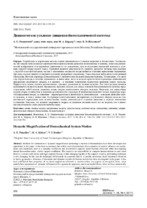Динамическое усиление движения биомеханической системы

Date
2017Publisher
Another Title
Dynamic Magnification of Biomechanical System Motion
Bibliographic entry
Покатилов, А. Е. Динамическое усиление движения биомеханической системы = Dynamic Magnification of Biomechanical System Motion / А. Е. Покатилов, М. А. Киркор, В. И. Ильенков // Наука и техника. – 2017. – № 4. - С. 348-354.
Abstract
Разработаны и опробованы методы оценки динамического усиления движения в биомеханике. Установлено, что широко используемые характеристики оценки влияния движения на механизмы и машины, такие как динамический коэффициент и коэффициент динамичности по ускорениям, при исследовании локомоций человека в условиях упругой опоры теряют смысл. Причиной является невозможность сравнить движение человека при контакте с упругой и жесткой опорами, так как с изменением жесткости опоры меняется и техника выполнения упражнения. При этом она еще зависит от текущего состояния конкретного спортсмена. Такая ситуация наблюдается в спортивной гимнастике. Изучена структура кинематических и динамических моделей движения человека. Установлено, что свойства упругой опоры в моделях отражаются: в явном виде, когда в моделях присутствуют параметры динамической деформации спортивного снаряда, и в неявном – в численно измененных параметрах движения самого человека. Первую часть можно оценить количественно, сравнив с расчетами по полным моделям. Для этого введены понятия выделенной и полной моделей. Предложено выделять модели для опоры и модели биомеханической системы, представляющие собой модели движения только опорно-двигательного аппарата человека. Выявлено, что выделенные модели опоры в кинематике и динамике различаются по структуре. В кинематике выделяют только параметры упругой деформации опоры, а в динамике – параметры опоры в явном виде и дополнительно – в моделях движения самого человека, и тоже в явном виде. На примере вычислительного эксперимента для большого оборота назад на гимнастической перекладине дана количественная оценка динамического усиления движения в моделях кинематики и динамики. Показано, что влияние спортивного снаряда на движение численно имеет тот же порядок, что и движение спортсмена без учета упругих свойств опоры.
Abstract in another language
Methods for estimation of dynamic magnification pertaining to motion in biomechanics have been developed and approbаted in the paper. It has been ascertained that widely-used characteristics for evaluation of motion influence on mechanisms and machinery such as a dynamic coefficient and acceleration capacity factor become irrelevant while investigating human locomotion under elastic support conditions. The reason is an impossibility to compare human motion in case when there is a contact with elastic and rigid supports because while changing rigidity of the support exercise performing technique is also changing. In this case the technique still depends on a current state of a specific sportsman. Such situation is observed in sports gymnastics. Structure of kinematic and dynamic models for human motion has been investigated in the paper. It has
been established that properties of an elastic support are reflected in models within two aspects: in an explicit form, when models have parameters of dynamic deformation for a gymnastic apparatus, and in an implicit form, when we have numerically changed parameters of human motion. The first part can be evaluated quantitatively while making comparison with calculations made in accordance with complete models. For this reason notions of selected and complete models have been introduced in the paper. It has been proposed to specify models for support and models of biomechanical system that represent models pertaining only to human locomotor system. It has been revealed that the selected models of support in kinematics and dynamics have structural difference. Kinematics specifies only parameters of elastic support deformation and dynamics specifies support parameters in an explicit form and additionally in models of human motion in an explicit form as well. Quantitative estimation of a dynamic motion magnification in kinematics and dynamics models has been given while using computing experiment for grand circle backward on a gymnastics horizontal bar as an example. It has been shown that an influence of a gymnastic apparatus on motion has numerically the same order as motion of a sportsman without taking into account elastic properties of the support.
View/
Collections
- №4[11]
